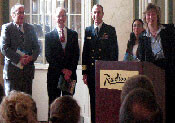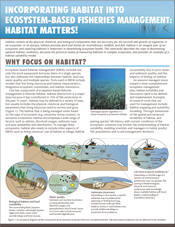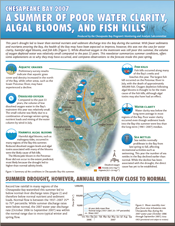National Estuarine Eutrophication Assessment report available
Printed copies of the report - "Effects of nutrient enrichment in the nation's estuaries: A decade of change" - are now available. Please contact Suzanne Bricker to obtain a copy.DoD report on Bay restoration and partnerships released
 As one of the largest landholders in the Chesapeake Bay watershed, the Department of Defense (DoD) plays an important role in Bay restoration and protection. Defending Our National Treasure: A Department of Defense Chesapeake Bay Restoration Partnership 1998-2004 showcases the DoD's restoration activities and effective partnerships with federal agencies, state and local governments, and non-profit organizations. The report also illustrates the issues impacting the Bay through informative visuals, maps, and diagrams; thus, Defending Our National Treasure serves as an educational tool for anyone interested in the history, ecology, or health of the Bay. This report-a collaboration between IAN, Chesapeake Watershed Cooperative Ecosystem Studies Unit, and DoD-was released at the DoD/EPA States Region III Environmental Colloquium in Baltimore, MD.
As one of the largest landholders in the Chesapeake Bay watershed, the Department of Defense (DoD) plays an important role in Bay restoration and protection. Defending Our National Treasure: A Department of Defense Chesapeake Bay Restoration Partnership 1998-2004 showcases the DoD's restoration activities and effective partnerships with federal agencies, state and local governments, and non-profit organizations. The report also illustrates the issues impacting the Bay through informative visuals, maps, and diagrams; thus, Defending Our National Treasure serves as an educational tool for anyone interested in the history, ecology, or health of the Bay. This report-a collaboration between IAN, Chesapeake Watershed Cooperative Ecosystem Studies Unit, and DoD-was released at the DoD/EPA States Region III Environmental Colloquium in Baltimore, MD.
Incorporating habitat into ecosystem-based fisheries management
 The second in a series of newsletters on ecosystem-based fisheries management (EBFM), this newsletter discusses the role of habitat in EBFM. Habitat consists of the physical, chemical, and biological components that are necessary for the survival and growth of organisms in an ecosystem. The newsletter describes the steps in determining optimal habitat conditions, discusses the practical reality of measuring habitats in complex ecosystems, and provides an example of a habitat suitability model. Produced in collaboration with NOAA's Chesapeake Bay Office.
The second in a series of newsletters on ecosystem-based fisheries management (EBFM), this newsletter discusses the role of habitat in EBFM. Habitat consists of the physical, chemical, and biological components that are necessary for the survival and growth of organisms in an ecosystem. The newsletter describes the steps in determining optimal habitat conditions, discusses the practical reality of measuring habitats in complex ecosystems, and provides an example of a habitat suitability model. Produced in collaboration with NOAA's Chesapeake Bay Office.
A summer of poor water clarity, algal blooms, and fish kills (Summer lookback newsletter)
 This year's drought led to lower than normal nutrient and sediment discharge into the Bay during the summer. With fewer sediments and nutrients entering the Bay, the health of the Bay may have been expected to improve, however, this was not the case for water clarity, harmful algal blooms, and fish kills. While dissolved oxygen in the mainstem was still poor this summer, the volume of oxygen depleted water was relatively small compared to the past 22 years. This newsletter summarizes summer conditions, offers some explanations as to why they may have occurred, and compares observations to the forecast made this past spring. Produced in collaboration with the Chesapeake Bay Program's Monitoring and Analysis Subcommittee.
This year's drought led to lower than normal nutrient and sediment discharge into the Bay during the summer. With fewer sediments and nutrients entering the Bay, the health of the Bay may have been expected to improve, however, this was not the case for water clarity, harmful algal blooms, and fish kills. While dissolved oxygen in the mainstem was still poor this summer, the volume of oxygen depleted water was relatively small compared to the past 22 years. This newsletter summarizes summer conditions, offers some explanations as to why they may have occurred, and compares observations to the forecast made this past spring. Produced in collaboration with the Chesapeake Bay Program's Monitoring and Analysis Subcommittee.
New IAN personnel
 Katie Foreman joined UMCES and the Chesapeake Bay Program as the new non-tidal water quality analyst. She is an Iowa native, where she received her undergraduate and graduate degrees in geography from the University of Iowa. Over the past 6 years, Katie has spent many hours in Iowa's lakes, streams, and rivers working as a researcher for the Iowa Department of Natural Resources. She worked in several programs within the Department including: Beach Monitoring, Volunteer Water Quality Monitoring, Watershed Improvement, and Watershed Monitoring and Assessment. In her free time she looks forward to riding her horse, practicing yoga, and learning how to sail.
Katie Foreman joined UMCES and the Chesapeake Bay Program as the new non-tidal water quality analyst. She is an Iowa native, where she received her undergraduate and graduate degrees in geography from the University of Iowa. Over the past 6 years, Katie has spent many hours in Iowa's lakes, streams, and rivers working as a researcher for the Iowa Department of Natural Resources. She worked in several programs within the Department including: Beach Monitoring, Volunteer Water Quality Monitoring, Watershed Improvement, and Watershed Monitoring and Assessment. In her free time she looks forward to riding her horse, practicing yoga, and learning how to sail.

